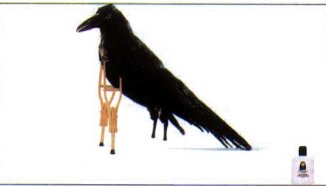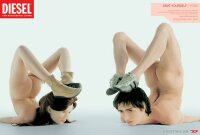ORIGINAL ADVERTSING IS SOMETIMES A RIDDLE
According to recent eye-tracking research, original ads are effective (Adformatie, no. 42). However, researchers Paul Ketelaar and Marnix van Gisbergen presume that too much originality will undo the positive effect.
Different interpretations Recent research at the University of Nijmegen (department of Communication), shows that most open ads are prone to multiple interpretations. It also shows that these different interpretations not necessarily obstruct the desired effectivity. By means of raising questions open ads maintain attention. They also often achieve a positive attitude towards the ad and the brand. During the study an inventory of the characteristics of open ads was made. Recipients' reactions were the starting-point for the classification. Open ads were divided into 4 categories: 'story', 'aesthetics', 'issue' and 'riddle'. The 'story' ad shows part of a story or event. Because of that it raises questions like: 'What's happening?, How does the story end?, What went on before?' This type of ad invites to different interpretations, but doesn't guide to a certain preferred interpretation. The category 'aesthetics' is intended as 'art to look at'. The image shows elements that lack any kind of relationship. The consumer accepts the tension and ambiguity, aroused by the image, and because of that consumers do not want to explain the image. The 'issue' invites the consumer to think and form an opinion towards a certain topic. The topic can be political of philosophical in nature. The fourth category, 'riddle', contains information that doesn't conform to existing memory-structures of ads and or products. They are 'schema-incongruent'. This incongruency invites the interpreter to solve the riddle. In the ad there's a clue, which contains a certain preferred interpretations, which reflexes the sender's intention. A way to create riddles in ads is using metaphors. To successfully unravel the metaphor seems to ask a lot of attention from the consumer. An amount of attention consumers ordinarily do not want to spend on ads. After all, the average viewing time is only a few seconds.
Crowfeet The study shows that riddles are not interpreted as unambiguous as advertisers might have assumed. Take for example the ad picturing a crow without paws, holding crutches, accompanied by a pot of Oil of Ulay. Text is missing. The preferred reading, intended by the advertiser, is: “Oil of Ulay makes crowfeet disappear” (makes laughing wrinkles disappear). But what the receiver extracts from the advertisement is more important than the intended message. Fifty students were therefore asked about their thoughts of the intended message. Only a few could discover the clue. Numerous meanings were described, mostly positive about the brand. A few quotations: “Oil of Ulay supports in maintaining a young skin”, “When you use this cream you will crow differently (Dutch saying)”, “Oil of Ulay helps birds after oil disasters”, “Old cripple people have to you use Oil of Ulay to get on their feet again”, “If you don't use Oil of Ulay, you will become an ugly old crow”, “People fight for Oil of Ulay, just as this blackbird did”. The ad has a positive effect, but not corresponding to the advertiser's intention. It is a pity for the advertiser that, despite the positive meanings, the ad wasn't evaluated positive by everyone. Especially consumers who (in their perception) didn't find or come up with a clue, were irritated by the ad.
In conclusion The categories mentioned above form a starting point for an intended content analysis. One of the study's hypotheses is that ads should not be too original (or complicated) to accomplish a positive effect. The results could be important to advertisers and media planning agencies who are interested in quantitative data as well as qualitative data. For example: which types of ads fit which kind of magazines and which kind of consumers? |
|||
Ketelaar, P. E., & Gisbergen, M. S. van (2000). Originele reclame is soms een raadsel.
[Translated: Original advertising is sometimes a riddle]. Adformatie, 48(28), p.34
|
|


